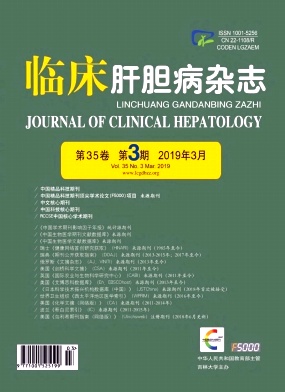|
[1] YOUNOSSI Z, HENRY L. Contribution of alcoholic and nonal-coholic fatty liver disease to the burden of liver related morbidi-ty and mortality[J]. Gastroenterology, 2016, 150 (8) :1778-1785.
|
|
[2] National Workshop on Fatty Liver and Alcoholic Liver Disease, Chinese Society of Hepatology, Chinese Medical Association;Fatty Liver Expert Committee, Chinese Medical Doctor Associ-ation. Guidelines of prevention and treatment for nonalcoholicfatty liver disease:A 2018 update[J]. J Clin Hepatol, 2018, 34 (5) :947-957. (in Chinese) 中华医学会肝病学分会脂肪肝和酒精性肝病学组, 中国医师协会脂肪性肝病专家委员会.非酒精性脂肪性肝病防治指南 (2018年更新版) [J].临床肝胆病杂志, 2018, 34 (5) :947-957.
|
|
[3] WINSTON D, VIJAY HS. Pathogenesis of alocholic liver dis-ease[J]. Clin Liver Dis, 2016, 20 (3) :445-456.
|
|
[4] BODE JC, BODE C, HEIDELBACH R, et al. Microflora in pa-tients with chronic alcohol abuse[J]. Hepatogastroenterology, 1984, 31 (1) :30-34.
|
|
[5] CASAFONT MORENCOS F, de LAS HERAS CASTAO G, MARTNRAMOS L, et al. Smal bowel bacterial overgrowth in patients withalcoholic cirrhosis[J]. Dig Dis Sci, 1996, 41 (3) :552-556.
|
|
[6] GABBARD SL, LACY BE, LEVINE GM, et al. The impact of al-cohol consumption and cholecystectomy on small intestinalbacterial overgrowth[J]. Dig Dis Sci, 2014, 59 (3) :638-644.
|
|
[7] BULL-OTTERSON L, FENG W, KIRPICH I, et al. Metagenomicanalyses of alcohol induced pathogenic alterations in the intestinalmicrobiome and the effect of Lactobacillus rhamnosus GG treat-ment[J]. PLo S One, 2013, 8 (1) :e53028.
|
|
[8] VISAPJP, TILLONEN J, SALASPURO M. Microbes and muco-sa in the regulation of intracolonic acetaldehyde concentrationduring ethanol challenge[J]. Alcohol Alcohol, 2002, 37 (4) :322-326.
|
|
[9] MUTLU EA, GILLEVET PM, RANGWALA H, et al. Colonic mi-crobiome is altered in alcoholism[J]. Am J Physiol Gastroint-est Liver Physiol, 2012, 302 (9) :g966-g978.
|
|
[10] YANG AM, INAMINE T, HOCHRATH K, et al. Intestinal fungicontribute to development of alcoholic liver disease[J]. J ClinInvest, 2017, 127 (7) :2829-2841.
|
|
[11] ENGEN PA, GREEN SJ, VOIGT RM, et al. The gastrointesti-nal microbiome:Alcohol effects on the composition of intestinalmicrobiota[J]. Alcohol Res, 2015, 37 (2) :223-236.
|
|
[12] SOKOL H, PIGNEUR B, WATTERLOT L, et al. Faecalibacteri-um prausnitzii is an anti-inflammatory commensal bacterium i-dentified by gut microbiota analysis of Crohn disease patients[J]. Proc Natl Acad Sci U S A, 2008, 105 (43) :16731-16736.
|
|
[13] BAJAJ JS, HEUMAN DM, HYLEMON PB, et al. Altered profileof human gut microbiome is associated with cirrhosis and itscomplications[J]. J Hepatol, 2014, 60 (5) :940-947.
|
|
[14] YAN AW, FOUTS DE, BRANDL J, et al. Enteric dysbiosis as-sociated with a mouse model of alcoholic liver disease[J].Hepatology, 2011, 53 (1) :96-105.
|
|
[15] LIPPAI D, BALA S, CATALANO D, et al. MicroRNA-155 de-ficiency prevents alcohol-induced serum endotoxin increaseand small bowel inflammation in mice[J]. Alcohol Clin ExpRes, 2014, 38 (8) :2217-2224.
|
|
[16] WANG Y, TONG J, CHANG B, et al. Effects of alcohol on in-testinal epithelial barrier permeability and expression of tightjunction associated proteins[J]. Mol Med Rep, 2014, 9 (6) :2352-2356.
|
|
[17] WANG L, FOUTS DE, STRKEL P, et al. Intestinal REG3 lec-tins protect against alcoholic steatohepatitis by reducing mu-cosa-associated microbiota and preventing bacterial translo-cation[J]. Cell Host Microbe, 2016, 19 (2) :227-239.
|
|
[18] LLOPIS M, CASSARD AM, WRZOSEK L, et al. Intestinal mi-crobiota contributes to individual susceptibility to alcoholic liverdisease[J]. Gut, 2016, 65 (5) :830-839.
|
|
[19] FERRERE G, WRZOSEK L, CAILLEUX F, et al. Fecal microbi-ota manipulation prevents dysbiosis and alcohol-induced liverinjury in mice[J]. J Hepatol, 2017, 66 (4) :806-815.
|
|
[20] TILLONEN J, VKEVINEN S, SALASPURO V, et al. Metron-idazole increases intracolonic but not peripheral blood acetal-dehyde in chronic ethanol-treated rats[J]. Alcohol Clin ExpRes, 2000, 24 (4) :570-575.
|
|
[21] SINGH R, BULLARD J, KALRA M, et al. Status of bacterial colo-nization, Toll-like receptor expression and nuclear factor-kappaB activation in normal and diseased human livers[J]. Clin Immu-nol, 2011, 138 (1) :41-49.
|
|
[22] PUROHIT V, BODE JC, BODE C, et al. Alcohol, intestinal bacteri-al growth, intestinal permeability to endotoxin, and medical con-sequences:Summary of a symposium[J]. Alcohol, 2008, 42 (5) :349-361.
|
|
[23] ROH YS, ZHANG B, LOOMBA R, et al. TLR2 and TLR9 con-tribute to alcohol-mediated liver injury through induction ofCXCL1 and neutro-phil infiltration[J]. Am J Physiol Gastroi-ntest Liver Physiol, 2015, 309 (1) :g30-g41.
|
|
[24] QIN N, YANG F, LI A, et al. Alterations of the human gut micro-biome in liver cirrhosis[J]. Nature, 2014, 513 (7516) :59-64.
|
|
[25] NANJI AA, KHETTRY U, SADRZADEH SM. Lactobacillus feedingreduces endotoxemia and severity of experimental alcoholic liver (disease) [J]. Proc Soc Exp Biol Med, 1994, 205 (3) :243-247.
|
|
[26] KIRPICH IA, SOLOVIEVA NV, LEIKHTER SN, et al. Probioticsrestore bowel flora and improve liver enzymes in human alco-hol-induced liver injury:A pilot study[J]. Alcohol, 2008, 42 (8) :675-682.
|
|
[27] STADLBAUER V, MOOKERJEE RP, HODGES S, et al. Effectof probiotic treatment on deranged neutrophil function and cy-tokine responses in patients with compensated alcoholic cir-rhosis[J]. J Hepatol, 2008, 48 (6) :945-951.
|
|
[28] KALMAN RS, GOLDBERG DS. The role of obeticholic acid ingut bacterial translocation and inflammation[J]. Gastroenter-ology, 2016, 151 (4) :759-761.
|
|
[29] WOODHOUSE CA, PATEL VC, SINGANAYAGAM A, et al.Review article:The gut microbiome as a therapeutic target inthe pathogenesis and treatment of chronic liver disease[J].Aliment Pharmacol Ther, 2018, 47 (2) :192-202.
|
|
[30] BAJAJ JS, KASSAM Z, FAGAN A, et al. Fecal microbiotatransplant from a rational stool donor improves hepatic en-cephalopathy:A randomized clinical trial[J]. Hepatology, 2017, 66 (6) :1727-1738.
|
|
[31] XING HC, LI LJ, XU KJ, et al. Protective role of supplementwith foreign Bifidobacterium and Lactobacillus in experimentalhepatic ischemia-reperfusion injury[J]. J Gastroenterol Hep-atol, 2006, 21 (4) :647-656.
|







 DownLoad:
DownLoad: